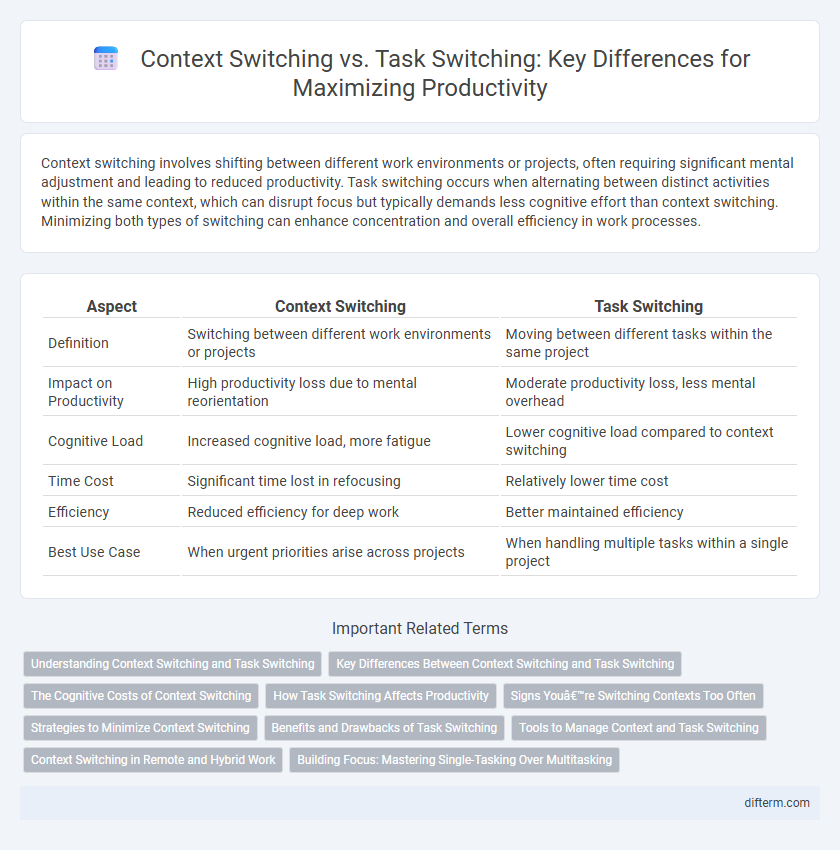Context switching involves shifting between different work environments or projects, often requiring significant mental adjustment and leading to reduced productivity. Task switching occurs when alternating between distinct activities within the same context, which can disrupt focus but typically demands less cognitive effort than context switching. Minimizing both types of switching can enhance concentration and overall efficiency in work processes.
Table of Comparison
| Aspect | Context Switching | Task Switching |
|---|---|---|
| Definition | Switching between different work environments or projects | Moving between different tasks within the same project |
| Impact on Productivity | High productivity loss due to mental reorientation | Moderate productivity loss, less mental overhead |
| Cognitive Load | Increased cognitive load, more fatigue | Lower cognitive load compared to context switching |
| Time Cost | Significant time lost in refocusing | Relatively lower time cost |
| Efficiency | Reduced efficiency for deep work | Better maintained efficiency |
| Best Use Case | When urgent priorities arise across projects | When handling multiple tasks within a single project |
Understanding Context Switching and Task Switching
Context switching involves shifting attention between different tasks that require distinct cognitive frameworks, leading to increased mental fatigue and reduced efficiency. Task switching refers to moving between different activities within the same overall task or project, generally causing less cognitive load but still interrupting workflow. Understanding the difference helps optimize productivity by minimizing unnecessary transitions and maintaining deeper focus on primary objectives.
Key Differences Between Context Switching and Task Switching
Context switching involves shifting attention between different environments or workflows, often requiring changes in tools or settings, while task switching refers to moving between distinct tasks within the same context. Context switching typically incurs higher cognitive costs and time delays due to reorientation to new stimuli and processes. Task switching generally allows quicker resumption of work but can still degrade focus and reduce overall productivity when performed frequently.
The Cognitive Costs of Context Switching
Context switching incurs significant cognitive costs by forcing the brain to repeatedly reorient to new environments, which depletes mental resources and reduces overall productivity. Task switching, while similar, often involves transitioning between related activities, minimizing cognitive overhead compared to full context shifts. Research shows that the cognitive load during context switching can increase error rates and extend task completion times by up to 40%.
How Task Switching Affects Productivity
Task switching reduces productivity by increasing cognitive load and causing a loss of focus, leading to longer completion times for each task. Frequent task switching triggers the brain to reorient repeatedly, which depletes mental resources and results in more errors. Studies show that productivity can drop by up to 40% when multitasking or switching tasks without finishing them.
Signs You’re Switching Contexts Too Often
Frequent context switching often causes scattered focus, increased task completion time, and mental fatigue, signaling inefficient productivity habits. Signs include frequent interruptions, inability to complete tasks before starting new ones, and a constant feeling of being overwhelmed or distracted. Recognizing these signs helps implement strategies like time-blocking to maintain deeper focus and reduce productivity loss.
Strategies to Minimize Context Switching
Minimizing context switching enhances productivity by reducing cognitive load and maintaining focus. Strategies include batching similar tasks, using time-blocking techniques, and setting clear priorities to limit interruptions. Implementing tools like distraction blockers and single-tasking methods further preserves mental clarity and workflow efficiency.
Benefits and Drawbacks of Task Switching
Task switching allows individuals to address multiple responsibilities in shorter time frames, promoting flexibility and responsiveness in dynamic work environments. However, frequent task switching can lead to increased cognitive load, causing diminished focus, higher error rates, and longer overall completion times. Balancing task switching with focused work intervals is crucial to maintain productivity and minimize the drawbacks associated with constant mental shifts.
Tools to Manage Context and Task Switching
Effective tools to manage context switching and task switching include digital task managers like Trello and Asana, which help organize and prioritize tasks to reduce cognitive load. Time-tracking applications such as Toggl enable users to monitor work intervals, minimizing unnecessary switches and preserving focus. Integrating techniques like the Pomodoro method within these tools enhances productivity by structuring work sessions and breaks systematically.
Context Switching in Remote and Hybrid Work
Context switching in remote and hybrid work environments significantly decreases productivity by forcing employees to constantly refocus between different projects, communication channels, and workspaces. Unlike task switching, which often involves alternating between related tasks, context switching demands a mental adjustment to entirely different roles or objectives, increasing cognitive load and causing longer recovery times. Minimizing context switching through structured schedules, dedicated work zones, and focused communication tools enhances efficiency and reduces burnout in distributed teams.
Building Focus: Mastering Single-Tasking Over Multitasking
Context switching disrupts cognitive flow by forcing the brain to adapt to new tasks, resulting in significant productivity loss and increased error rates. Task switching involves alternating between different activities but can fragment attention and reduce the quality of work output. Mastering single-tasking enhances focus by enabling deeper concentration, improving information retention, and accelerating task completion.
Context switching vs Task switching Infographic

 difterm.com
difterm.com